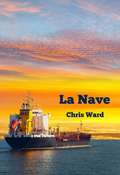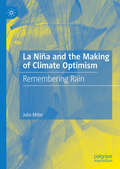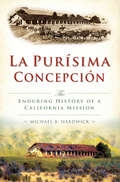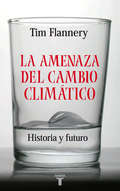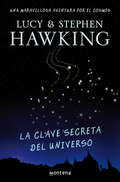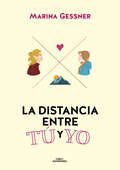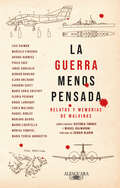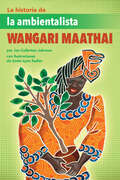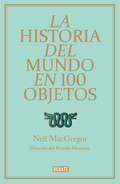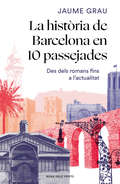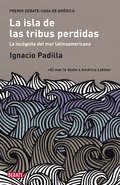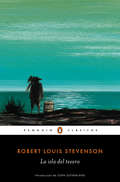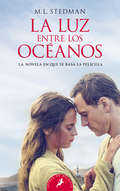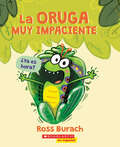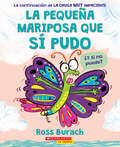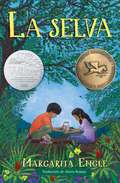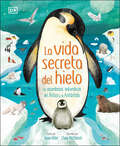- Table View
- List View
La Nave
by Chris Ward Roberto SpigarelliPer lo spotter navale Ken, l'apparizione del potente superpetroliere The Bostonian nel porto locale nell'ultima tappa del suo ultimo viaggio, è uno spettacolo troppo importante da perdere. Tuttavia, il bullo della scuola Max ha altre idee...
La Niña and the Making of Climate Optimism: Remembering Rain
by Julia MillerThis book examines the deep connection Australians have with their climate to understand contemporary views on human-induced climate change. It is the first study of the Australian relationship with La Niña and it explains how fundamental this relationship is to the climate change debate both locally and globally. While unease with the Australian environment was a hallmark of early settler relations with a new continent, this book argues that the climate itself quickly became a source of hope and linked to progress. Once observed, weather patterns coalesced into recognizable cycles of wet and dry years and Australians adopted a belief in the certainty of good seasons. It was this optimistic response to climate linked to La Niña that laid the groundwork for this relationship with the Australian environment. This book will appeal to scholars and students of the environmental humanities, history and science as well as anyone concerned about climate change.
La Primera Nevada de Clifford
by Norman BridwellOriginally published in English as Clifford's First Show Day
La Purisíma Concepción: The Enduring History of a California Mission (Brief History)
by Michael R. HardwickIn two centuries, La Purísima Concepción went from a fledgling frontier mission to a renowned California State Historic Park. Once home to many Spanish soldiers, settlers and hundreds of Chumash Indians, La Purísima held the seat of the California Mission government under Father Mariano Payeras. It withstood catastrophic events, including widespread disease in early years and a great Southern California earthquake in 1812. Emerging from ruins for the last time in 1934, after restoration by the Civilian Conservation Corps, structures appear today as they did in the early nineteenth century. The uniquely restored California Mission complex operates as a state park in a pastoral setting. Author and archivist Michael R. Hardwick chronicles the story of La Purísima and the resilient people and culture that made a lasting influence.
La amenaza del cambio climático
by Tim Flannery¿Qué significa el cambio climático? ¿Cómo afectará el calentamiento global a nuestras vidas? ¿Es la causa de las tormentas extremas y de las sequías cada vez más frecuentes? ¿Son inevitables estos sucesos? Con este libro, Tim Flannery responde a cuestiones tan urgentes como éstas y otras muchas. Para ayudarnos a comprender el dilema al que nos enfrentamos, nos cuenta con detalle la fascinante historia del clima y su posible futuro, pues si seguimos quemando combustibles fósiles, aumentarán los niveles de gases de efecto invernadero en la atmósfera y esto provocará un calentamiento del planeta aún mayor. A pesar de que cada país se ve influido de manera diferente por estos efectos no deseados, todos tenemos algo en común: la amenaza del cambio climático. La nueva meteorología que estamos generando pone en peligro el futuro de nuestra civilización. Tenemos que ser conscientes de que el estado de la atmósfera y del subsuelo, del agua y de la tierra depende de nosotros. Pero este reconocido científico va más allá de relatar la historia del clima y no pierde el optimismo. Con gran entusiasmo, Flannery muestra cómo podemos colaborar en la lucha contra estos problemas y nos transmite su confianza en una futura solución si todos nos implicamos. Nos sorprenderá lo mucho que aún podemos hacer. La amenaza del cambio climático nos puede cambiar la vida. Reseñas:«Por fin una explicación clara sobre una de las cuestiones más importantes y polémicas de la actualidad.»Jared Diamond «Éste es el libro que el mundo ha estado esperando -y necesitando- durante décadas. Por fin un libro que presenta, para el público general, la prueba irrefutable de que el cambio climático ya se está produciendo, y la necesidad de ser muy serios con este tema... rápidamente.»Peter Singer «Todo aquel que lea La amenaza del cambio climático podrá apreciar la fragilidad de nuestro clima y comprender que es ésta la generación que debe actuar para protegerla.»Tony Blair
La clave secreta del universo: Una maravillosa aventura por el cosmos (La clave secreta del universo #Volumen 1)
by Lucy HawkingCon La clave secreta del Universo el genial Stephen Hawking y su hija Lucy han conseguido acercar a los pequeños -y no tan pequeños- las maravillas y los secretos del Universo, y demostrarnos que la ciencia también puede ser divertida y apasionante. A George nada le gusta más en el mundo que mirar las estrellas; también le encantaría tener un ordenador con el que navegar y conocer más sobre el Universo, pero sabe que eso es misión imposible. En casa, sus padres son tan ecologistas que no quieren ni oír hablar del progreso y la ciencia. Pero lo que ellos no saben es que el enemigo está muy cerca. Acaba de llegar un nuevo vecino que, ¡horror!, es un eminente científico, y eso, para los padres de George, solo significa una cosa: peligro. Si hubieran imaginado lo que le esperaba a su hijo, nunca le habrían dejado entrar en su casa... Reseña:«Se juntan el asombro de un niño con la agudeza intelectual de un genio.»The Sunday Times
La colcha de retazos de la naturaleza: Entendamos los hábitats (¡Arriba la Lectura!, Read Aloud Module 9 #1)
by Mary Miché Consie PowellNIMAC-sourced textbook
La distancia entre tú y yo
by Marina GessnerUna inspiradora historia de amor, supervivencia y autoconocimiento que se convertirá en película de la mano de HBO. Una novela romántica juvenil que sigue la estela de grandes éxitos como Eleanor y Park o A dos metros de ti. McKenna es una chica afortunada. Tiene una familia que la quiere y un futuro por delante. Sin embargo, el verano antes de irse de casa, decide aparcarlo todo para recorrer el Sendero de los Apalaches por su cuenta. Sam no es un chico con suerte. Tras dejar su vida atrás para empezar de cero, ha encontrado un breve respiro en el Sendero, donde todos son vagabundos por un tiempo. A pesar de que sus vidas van en direcciones opuestas, McKenna y Sam se enamoran en un viaje cargado de emociones y altibajos. Y cuando su amor los desvía del camino, deberán esforzarse y luchar por su vida como nunca antes lo habían hecho.
La guerra menos pensada: Relatos y memorias de Malvinas
by Varios AutoresUn volumen con textos de diecisiete escritores y escritoras de diferentes generaciones que abordan un tema que se mantiene vigente desde hace cuarenta años: la guerra menos pensada, la guerra de Malvinas. Aunque ya han pasado cuarenta años, la guerra de Malvinas sigue siendo una herida abierta, un episodio que no se cierra. Se ha escrito mucho sobre el tema a lo largo de este tiempo pero no hay, que sepamos, ningún libro en el que se haya convocado a distintos escritores y escritoras, de diversas generaciones y estéticas a escribir sobre ella ahora, tantos años después. Este volumen reúne diecisiete textos muy diferentes entre sí, donde encontraremos memorias, crónicas, ficciones y autobiografías sobre el tema con la particularidad de que ninguno de los autores había escrito antes sobre la guerra menos pensada, la que nunca nadie imaginó y que, todavía hoy nos sigue doliendo porque Malvinas está, como suele decirse, en nuestro ADN, en la historia argentina. «Si el origen de la ficción nacional está marcado por la violencia, especialmente la violencia política, y si nuestra narrativa nunca despreció hacerse cargo de los hitos históricos, Malvinas se acomoda perfectamente dentro de esos parámetros. Porque Malvinas es mucho más que una guerra perdida, es la dictadura militar enviando a la muerte o a la mutilación (física, mental) a miles de soldados conscriptos, es un pueblo triunfalista, una muchedumbre que primero aplaudió y luego insultó, es una generación cuya banda de sonido se cantaba en castellano, es la negación en los años siguientes y es el tibio florecer de una consciencia social, de una causa común, de un dolor compartido en las últimas décadas».Del prólogo de Sergio Olguín
La historia de la ambientalista Wangari Maathai (The Story of Environmentalist Wangari Maathai)
by Jen Cullerton JohnsonEsta entrada inspiradora en la series de "Historia" de libros por capítulos biográficos se enfoca en Wangari Maathai, la primera mujer africana, y ambientalista, a ganar el Premio Nobel de Paz. This inspiring entry in the "Story of" line of chapter-book biographies features Wangari Maathai, the first African woman, and environmentalist, to win a Nobel Peace Prize.Wangari creció amando la naturaleza alrededor de ella en Kenia: desde los árboles mugumo hasta el río y los renacuajos que nadaban en él. Aunque muchas mujeres en Kenia no recibían educación, la familia de Wangari apoyó su curiosidad y pudo aprender muchas cosas maravillosas sobre el medio ambiente en cursos de ciencia. Sus estudios la llevaron lejos de su hogar, pero cuando vio que el Gobierno de su país estaba maltratando sus amados mugumos y el río, ella regresó con un plan. Sus ideas protegieron el ecosistema y a la vez promovieron los derechos de sus paisanas, y la hicieron la primer mujer africana y ambientalista a ganar el Premio Nobel de Paz. La historia de dedicación de Maathai empoderadá a todos los que amen las bellezas que ofrece el mundo natural. Este libro por capítulos incluye ilustraciones en blanco y negro, así como barras laterales sobre temas relacionados, una línea detiempo, un glosario y lecturas recomendadas. Perfecto para lectores que buscan pasar de libros ilustrados al siguiente nivel de lectura. Wangari grew up loving the nature around her in Kenya: from the mugumo trees to the river and the tadpoles that swam within it. Though many women in Kenya didn't receive an education, Wangari's family supported her curiosity and she was able to learn many wonderful things about the environment in science classes. Her studies took her far from home, but when she saw that her country's government was mistreating her beloved mugumos and river, she came back with a plan. Her ideas protected the ecosystem and promoted her countrywomen's rights at the same time, and they made her the first African woman and environmentalist to win the Nobel Peace Prize. The story of Maathai's dedication will empower all who love the beautiful things the natural world offers. This chapter-book edition includes black-and-white illustrations as well as sidebars on related subjects, a timeline, a glossary, and recommended reading. Perfect for readers looking to move from picture books to the next reading level.Check out the other titles in this series:LA HISTORIA DEL HÉROE DE LOS DERECHOS CIVILES JOHN LEWIS • LA HISTORIA DE LA ESTRELLA DE CINE ANNA MAY WONG
La historia de la nieve: La ciencia de la maravilla del invierno (¡Arriba la Lectura!, Read Aloud Module 6 #2)
by Mark Cassino Jon Nelson Nora AoyagiNIMAC-sourced textbook
La historia del mundo en 100 objetos
by Neil MacgregorEste libro ofrece un enfoque único de la historia de la humanidad a través del estudio de objetos que las distintas civilizaciones, a menudo sin pretenderlo, han ido dejando a su paso. Estas obras se convierten en una suerte de prismas a través de los cuales podemos explorar mundos antiguos y conocer algo más sobre las vidas de los hombres y mujeres que los habitaron. El campo de estudio que abarca es enorme, comienza con el primer objeto fabricado por manos humanas que se conserva, una herramienta para cortar procedente de la Garganta de Olduvai, en África, y termina con un objeto del siglo XXI que representa el mundo en el que vivimos hoy en día.El propósito de Neil Mac Gregor no es ofrecer una mera descripción de estos valiosísimos objetos sino mostrarnos su significado: cómo una columna de piedra nos habla sobre un gran emperador indio que predicaba tolerancia a su pueblo, cómo monedas españolas de ocho, acuñadas en Potosí, nos explican los orígenes de una moneda global, o cómo un juego de té de la época victoriana nos revela cuál fue la importancia del imperio.Cada capítulo sumerge al lector en una civilización pasada y lo acompaña con una guía de excepción. Vista de este modo, la historia es un caleidoscopio, cambiante, interrelacionado, sorprendente, que configura nuestro mundo contemporáneo de un modo que la mayoría de nosotros nunca habríamos imaginado. Un festín para el intelecto y para la vista, uno de los libros de historia más originales y fascinantes que se han publicado en años.
La història de Barcelona en 10 passejades: Des dels romans fins a l'actualitat
by Jaume Grau MasbernatDes de la ruta de l'aigua, de les revoltes, de les guerres o de les epidèmies fins a la ruta del treball, de les obres i especulació o la Barcelona màgica, Jaume Grau ens convida a caminar per la ciutat per descobrir tota la seva història. La millor manera de conèixer Barcelona és caminant-la. En els seus carrers i places hi ha escrita tota la seva història i només cal obrir bé els ulls per descobrir-la. La Barcelona d'avui és el testimoni viu de les Barcelones d'ahir, i en les seves pedres ha quedat imprès un relat històric apassionant. Les deu rutes temàtiques que proposa Jaume Grau per recórrer la ciutat es poden fer caminant, cadascú seguint el seu pas, o, fins i tot, dissenyant el seu propi trajecte. Des de la ruta de l'aigua, de les revoltes, de les guerres o de les epidèmies fins a la ruta del treball, de les obres i de l'especulació o de la Barcelona màgica, l'autor ens convida a mirar-la a través de la història.Una ciutat que amaga molts més racons i curiositats dels que ens hauríem pogut imaginar, com saber per exemple què hi fa una sabata a la façana de la catedral. Però també ens revela un passat dur i difícil, com el que podem observar al turó de la Rovira, on centenars de barcelonins van instal·lar les seves barraques sobre els antics emplaçaments dels canons antiaeris, que defensaven la ciutat dels atacs de l'aviació italiana. Obriu les pàgines d'aquest llibre, passegeu, mireu i passeu-vos-ho bé: la ciutat que caminareu és única, «la gran encisera», com la va definir Joan Maragall. Ressenya:«Passejar amb el llibre a la mà, seguint un dels itineraris que proposa, ens apropa a aquest món ocult i sorprenentment molt viu d'una ciutat tan intensa com és Barcelona. Està molt bé veure els monuments i les atraccions barcelonines amb ulls de turista, però potser ja és hora d'anar una mica més enllà i mirar-se Barcelona amb els ulls de la Història, de la vida, en definitiva.»Enric Calpena
La isla de las tribus perdidas
by Ignacio Padilla«Un mundo abrumado por su propia naturaleza, visto a través de las metáforas del agua, surge ante nosotros en este ensayo deslumbrante que recorre la tradición literaria de todo un continente», así justificaba su fallo el jurado del III Premio Iberoamericano de Ensayo Debate-Casa de América. En efecto, La isla de las tribus perdidas es una elegante narración que sigue la estela de Ulises y retoma los motivos clásicos del naufragio, la tempestad, el barco o la isla, para contar cómo Latinoamérica se convierte sin quererlo en el reverso de Occidente. Una bella inmersión en las fuentes literarias americanas donde Gabriel García Márquez, Julio Cortázar, Jorge Luis Borges, Carlos Fuentes, Juan Carlos Onetti o Alejo Carpentier son las aguas en que se refleja la relación conflictiva de un continente con el mar, pues tanto le duele el mar a América Latina que decidió vivir de espaldas a él.
La isla del tesoro
by Robert Louis StevensonLa isla del tesoro (1883), una vibrante historia sobre la búsqueda de un tesoro enterrado, presenta el bien bajo la forma de Jim, un niño que se ve envuelto en la aventura y que a su vez debe descubrir por sí mismo la cara del bien y del mal entre sus bondadosos amigos y los piratas Pew y Long John Silver.
La isla del tesoro
by Robert Louis StevensonLa aventura iniciática de un joven en busca del tesoro perdido de un pirata. La novela de aventuras por excelencia. Jim Hawkins regenta, junto a sus padres, la posada Almirante Benbow. Su vida discurre tranquila entre la barra y las mesas hasta que, un día, un viejo marinero entra en su fonda acarreando un pesado cofre de madera que oculta un valioso mapa. . . De la noche a la mañana, el joven Jim se encuentra en la cubierta de La Hispaniola, rodeado de rudos mercenarios, ansiosos por encontrar el codiciado tesoro del capitán Flint. Durante la mayor hazaña de su vida, irá conociendo mejor a John «el Largo» Silver, el viejo pirata que lo empujó a la aventura, personaje fascinante y contrapunto perfecto al carácter sencillo e inocente de Jim. «Resume todo lo que yo le pido a la literatura. » Eduardo Mendoza
La luz entre los océanos
by M.L. StedmanPremio LIBRO DEL AÑO 2013 en Australia. Una historia sobre el amor y la pérdida y que ha sido llevada a la gran pantalla. Una mañana de abril de 1926, un bote encalla en la costa rocosa de una remota isla australiana. En su interior yacen un hombre muerto y un bebé que llora con desesperación. A su encuentro salen Tom Sherbourne, el farero, y su joven esposa, Isabel. Se han instalado en la isla para dejar atrás los horrores de la Primera Guerra Mundial, y lo único que ensombrece su felicidad es la incapacidad de tener hijos. Ante la impresión que les causa un ser tan frágil e indefenso, Tom e Isabel deciden seguir el dictado de sus corazones y adoptar a la criatura, sin notificar el hallazgo a las autoridades. Un par de años después, cuando llega a su conocimiento que la madre de la niña está viva y mantiene la esperanza de encontrar a su hija, las tensiones se desatan en la pareja. Isabel ya no concibe la vida sin la pequeña Lucy, pero la decisión que han de tomar y el sufrimiento de la madre biológica harán que los hechos se precipiten en una cadena de consecuencias imprevisibles. Reseñas:«Una historia hermosamente escrita sobre el amor y la pérdida, sobre el sentido del bien y el mal, y sobre lo que somos capaces de hacer por nuestros seres queridos.»The Boston Globe «Stedman atrapa al lector desde la primera página con exuberantes descripciones del hermoso y agreste paisaje, y con personajes inolvidables.»Booklist «Una novela extraordinaria e inolvidable.»The Guardian «Una novela de amor a un tiempo delicada y convincente.»The Sunday Times «Escrita con distinción [...], emocionante [...], de gran belleza.»USA Today «Stedman crea el contexto perfecto para que se desarrolle un desgarrador dilema moral [...]. Especialmente impresionante es la evolución, sutil y profunda, de los dos protagonistas.»Publishers Weekly «Estas vidas ajenas y distantes nos resultan cercanas y reconocibles.»The New Yorker «Stedman construye su novela en torno a un inteligente y conmovedor dilema moral.»Kirkus Reviews «Una lectura absorbente e inmensamente conmovedora.»Monica Ali, autora de Una vida posible
La miel (¡Arriba la Lectura! Level K #83)
by Julie HaydonNIMAC-sourced textbook <p><p> ¿Sabes cómo hacen la miel las abejas? ¿Sabes qué tarea cumple cada tipo de abeja? ¡Lee y lo sabrás!
La oruga muy hambrienta
by Eric CarleThe Spanish translation of The Very Hungry Caterpillar (Philomel) preserves the original simplicity and the appealing use of repetition and rhythm. The exquisite collage illustrations will delight children as a hungry caterpillar happily eats his way through pages of fabulous food and emerges a brilliantly colored butterfly.
La oruga muy impaciente (The Very Impatient Caterpillar)
by Ross BurachThis clever send-up of every child's biggest challenge -- being patient! -- is a STEM-friendly, laugh-out-loud comedy about metamorphosis.La divertida exploracion de Ross Burach de la metamorfosis te hara aletear de jubilo, y a la vez te brindara datos reales acerca de como las orugas se transforman en mariposas.Ross Burach's hilarious, tongue-in-cheek exploration of metamorphosis will make you flutter with glee, while also providing real facts about how caterpillars transform into butterflies.
La pequeña mariposa que sí pudo (The Little Butterfly that Could)
by Ross BurachWhat if I can't?¿En qué dirección están las flores? Por ahí, a 320 kilómetros. ¡¿Cómo voy a llegar tan lejos?! Vasovolando. ¿Puedo ire n avión? No. ¡Entonces no llegaré nunca! Esta simpática continuación de La oruga muy impaciente , de Ross Burach, es un cariñoso homenaje al esfuerzo de cada niño de perseverar ante los desafíos a la vez que una alegre lección sobre la migración de las mariposas. Recuerda: si no lo logras al primer intento, ¡vuela, vuela otra vez! Which way to the flowers?That way. 200 miles.How am I supposed to travel that far?!You fly.Can I take a plane?No. Then I'll never make it!This comical companion to Ross Burach's The Very Impatient Caterpillar pays loving homage to every child's struggle to persist through challenges while also delivering a lighthearted lesson on butterfly migration. Remember, if at first you don't succeed, fly, fly again!
La potencia del viento (¡Arriba la Lectura!, Level S #68)
by Jill BryantEl viento es aire en movimiento. Sirve para viajar y divertirse, y como fuente de energía renovable. Se cree que, en el futuro, el viento va a producir gran parte del suministro de la electricidad de todo el mundo. El viento también es un factor clave de fenómenos meteorológicos extremos, como los tornados y los huracanes. Ficción realista Nivel S • 2,837 palabras El viento es aire en movimiento. Sirve para viajar y divertirse, y como fuente de energía renovable. Se cree que, en el futuro, el viento va a producir gran parte del suministro de la electricidad de todo el mundo. El viento también es un factor clave de fenómenos meteorológicos extremos, como los tornados y los huracanes. Estudiamos el viento para aprovechar su potencia para generar energía, y también para proteger a las casas y otros edificios de las tormentas destructivas. NIMAC-sourced textbook
La selva (Forest World)
by Margarita EngleNow in Spanish, award-winning author Margarita Engle’s lively middle grade novel in verse about a Cuban-American boy who visits his family’s village in Cuba for the first time—and meets a sister he didn’t know he had. <P><P>Edver isn’t happy about being shipped off to Cuba to visit the father he barely knows. Yet now that travel laws have changed and it’s a lot easier for divided families to be reunited, his mom thinks it's time for some father-son bonding. <P><P>Edver doesn’t know what this summer has in store, but he’s definitely not expecting to meet a sister he didn’t know existed! Luza is a year older and excited to see her little brother, until she realizes how different their lives have been. Looking for anything they might have in common, they sneak onto the internet—and accidentally catch the interest of a dangerous wildlife poacher. Edver has fought plenty of villains in video games. Now, to save the Cuban jungle they love, he and Luza are going to have to find a way to conquer a real villain! <P><P>A Edver no le hace ninguna gracia que lo envíen a Cuba a ver al padre que apenas conoce. Sin embargo, ahora que las leyes de viaje han cambiado y es mucho más fácil reunir a las familias divididas, su mamá piensa que es hora de que padre e hijo pasen tiempo juntos. Edver no se imagina lo que le depara el verano, ¡pero definitivamente no espera conocer a la hermana que ni siquiera sabía que existía! <P><P>Luza es un año mayor y está muy entusiasmada por conocer a su hermanito, hasta que se da cuenta de cuán diferentes han sido sus vidas. A la busca de cualquier cosa que puedan tener en común, se meten en internet y accidentalmente atraen la atención de un peligroso cazador de animales salvajes. Edver ha luchado contra muchísimos villanos en los videojuegos. <P><P>Ahora, para salvar la selva que tanto quieren, ¡Luza y él tendrán que encontrar un modo de derrotar a un villano real!
La vida en el desierto (¡Arriba la Lectura!, Level J #21)
by Lloyd KajikawaEl desierto es un lugar my seco y caluroso. Aprende cómo viven los animales en el desierto NIMAC-sourced textbook
La vida secreta del hielo (The Magic and Mystery of the Natural World)
by Jason BittelAdéntrate en 'La vida secreta del hielo' y embarca en un viaje increíble por los polos de la tierra.Osos polares, pingüinos y hielo se deslizan por las páginas de este colorido libro, que combina hermosas ilustraciones y fotos para ayudar a los niños más entusiastas a aprenderlo todo sobre el Ártico y la Antártida. Desde ríos helados hasta volcanes antárticos, descubrirán la increíble vida secreta de las regiones polares de la Tierra. También descubrirán cómo pueden ayudar a cuidar el Ártico y la Antártida.'La vida secreta del hielo' lleva a los niños por un deslumbrante viaje bajo cero, mostrándoles cuán increíbles son los polos de la tierra, qué plantas y animales viven cerca de ellos y cómo podemos ayudarlos. Incluye una multitud de vida polar, además de datos sorprendentes sobre cómo se forman los icebergs, cómo los animales sobreviven en el frío helado y cómo los científicos estudian la Antártida.Enter the world of the Arctic and Antarctic for an incredible journey around Earth&’s icy poles.Polar bears, penguins, and ice glide across the pages of this colorful book, which combines gorgeous illustrations and photos to help young enthusiasts learn all about the Arctic and Antarctic. From icy rivers to Antarctic volcanoes, they&’ll discover the incredible secret life of Earth&’s polar regions. They&’ll also find out how they can help take care of the Arctic and Antarctic themselves.'La vida secreta del hielo' takes children on a fascinating sub-zero journey, showing them just how amazing Earth&’s poles are, which plants and animals live near them, and how we can help them. It includes a multitude of polar life, plus amazing facts on how icebergs are formed, how animals survive in the freezing cold, and how scientists study the Antarctic.
